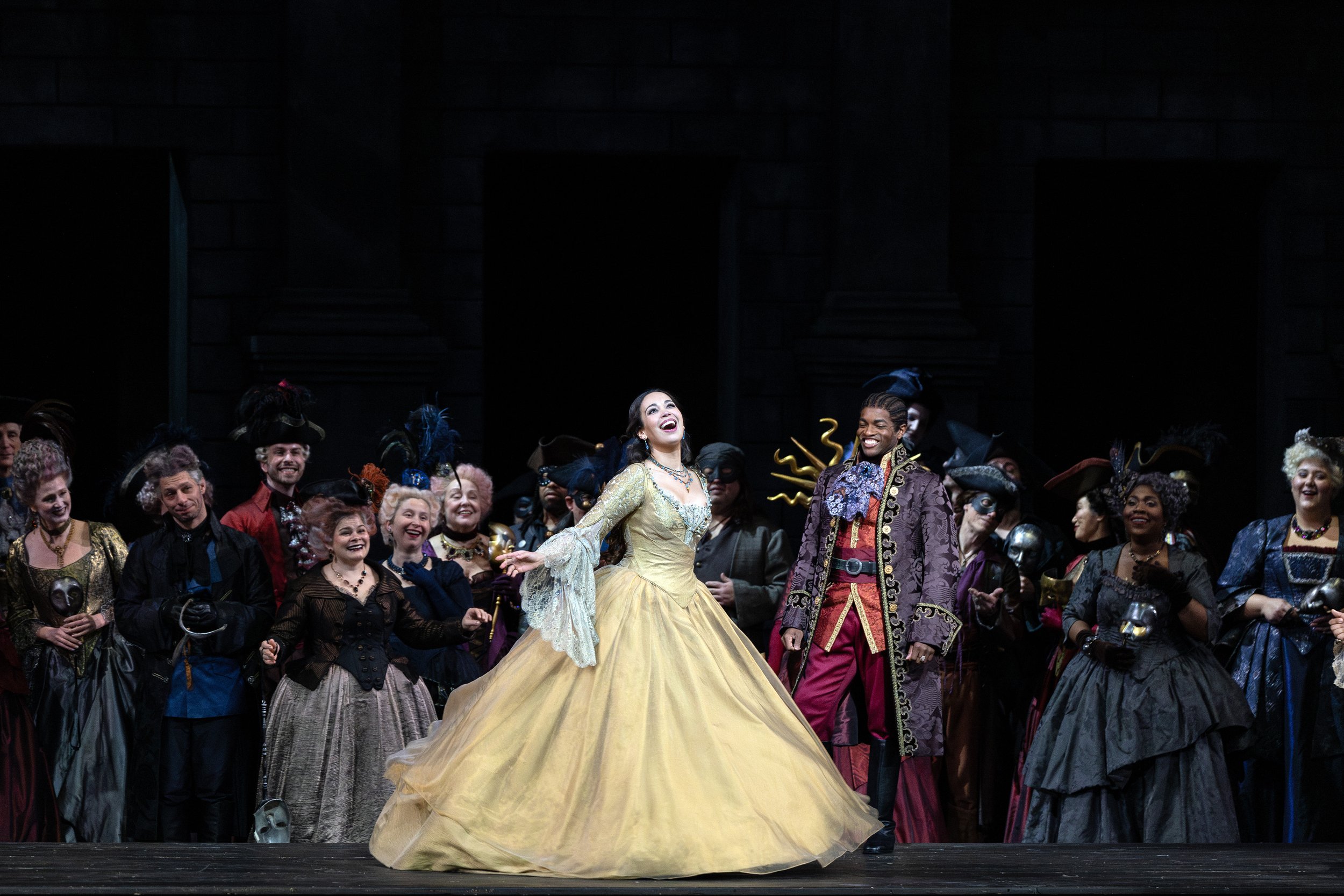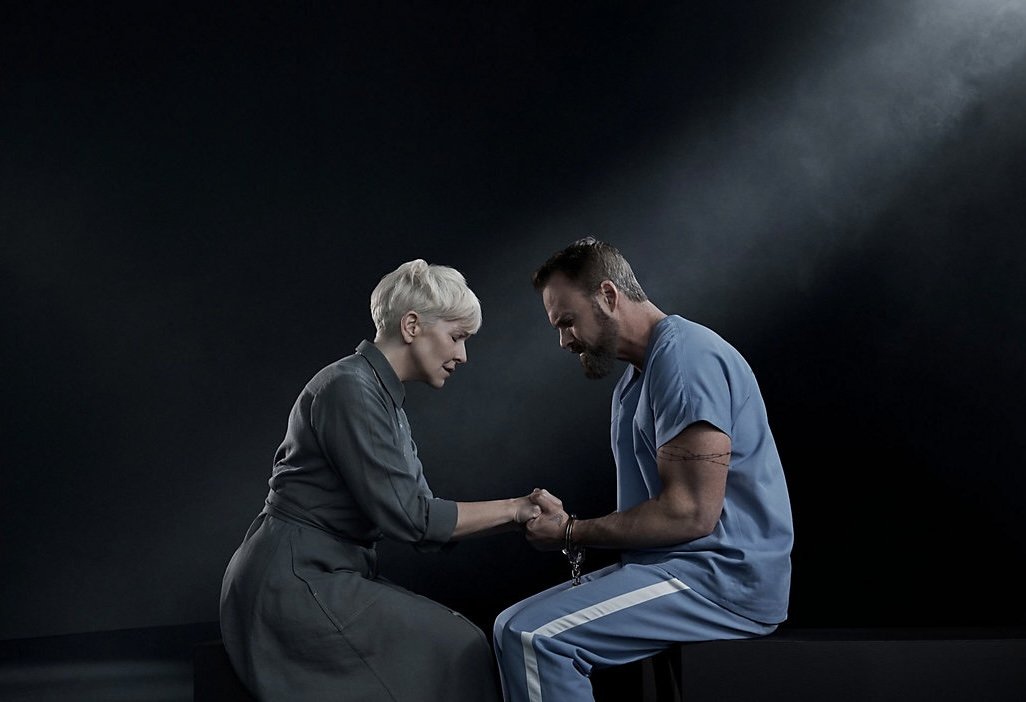Met Opera 2023-24 Review: Roméo et Juliette
Nadine Sierra and Benjamin Bernheim in Roméo et Juliette (Marty Sohl/Met Opera)
This review is for the performance on March 15.
Romeo and Juliet can usually be counted on to make you swoon and then weep, whether it’s in play, ballet, Broadway, or opera form. Still, a truly worthy cast should make the “sweet sorrow” fresh each time, rather than taking the tragedy’s ability to affect you for granted. The cast the Met has assembled for Gounod’s sublime Roméo et Juliette blows these and other standards away.
Nadine Sierra in Roméo et Juliette (Marty Sohl/Met Opera)
Sunshine practically radiated off Nadine Sierra during Juliette’s Waltz, “Je veux vivre,” (I want to live) which she sang with a carefree glee that carried through in her rich voice. It’s easy to forget that Juliette is 13 in Shakespeare’s play, and Nadine filled her with adolescent exuberance. As the opera went on and Juliette’s life collapsed in a grand total of four days, Nadine darkened her sound to reflect the character’s increasing maturity and woe. There are a few singing actresses currently active at the Met, but there are even fewer willing to audibly cry onstage. She brought down the house with her breathtakingly soaring rendition of the Potion Aria, which she encored at the Bilbao Opera in October.
Benjamin Bernheim’s Roméo was easygoing yet impulsive, jumping up angrily when Frederick Ballentine’s Tybalt insulted him but quickly restraining himself. Bernheim possesses a voice of uncommon beauty and sweetness, which more than makes up for its lack of brawn. The audience adored his dreamy “Ah, lève-toi, soleil” (Arise, sun), which displayed his limpid middle register to ideal effect. He was born in Paris and raised in Geneva, and his French diction is precise and fluid, which he will employ again next season as the title character in Offenbach’s Les Contes d’Hoffmann.
Benjamin Bernheim in Roméo et Juliette (Marty Sohl/Met Opera)
Together, Nadine and Bernheim were a dynamic pair. I wasn’t convinced of the lovers’ deep passion at first, but by their marriage, their chemistry was clear, as was the fact that their voices complement each other beautifully. During the bedroom duet, I was melting as Nadine tenderly cleaned Bernheim’s hands and face and tried to console him in Roméo’s anguish over killing Tybalt. Who dies first in the opera isn’t set in stone. (In the play, Romeo dies before Juliet even wakes up.) Here, Juliette fell dead out of Roméo’s arms and he took a last look at her before collapsing onto her body. It’s wrenching to think that Roméo had to see his beloved dead twice. You’re welcome.
I sobbed my eyes out — I think I’m becoming more and more of a hopeless case, because I managed to hold my sniffles until curtain call at Fedora, was less successful at Bohème, and let out a great big sniff at Roméo.
Samantha Hankey in Roméo et Juliette (Marty Sohl/Met Opera)
Last year’s Best Mezzo winner Samantha Hankey, prancing about in red pantaloons, looked like she was having a ball as Stéphano. Gounod's Montague page has only one aria, “Que fais-tu, blanche tourterelle,” (What are you doing, white turtledove) so I was pleased to see Stéphano with Roméo, Mercutio, and Benvolio at the Capulet party. During "Que fais-tu," Hankey infused the words “gardez-bien la belle” (guard well the beauty) with bite, taunting the Capulets. As she was suffering from a cold, her warm voice sounded somewhat modest in size; she later said that “light and bright” is her approach to singing while sick. Her piercing high notes, however, were stunning. Perhaps that was a taste of Hankey at 100%.
Will Liverman was a cheerful counter to Bernheim’s pensiveness. Compared to his recent star turn in the title role of X this season, Mércutio is a small role, but Liverman succeeded in leaving his mark on the evening. Eve Gigliotti was a feisty Gertrude, Juliette’s nurse, and Alfred Walker brought a reassuring presence to the stage as Frère Laurent. Plaudits to the organist for giving Juliette’s wedding to Paris a sinister sound!
Nadine Sierra (center) and Frederick Ballentine (right of her) in Roméo et Juliette (Marty Sohl/Met Opera)
Bartlett Sher’s traditional production has the same set for all five acts. It looks like a public square, with a balcony and a few houses on the sides. It’s adapted into different locations with a few props, such as a giant bedsheet for the bedroom scene and a door plus a few biers for the tomb. It’s certainly cost-effective, but it becomes monotonous after a while. Catherine Zuber’s costumes more than make up for that, particularly Juliette’s gorgeous golden ballgown in Act 1 and the flowy nightgown she wears for the rest. The production is supposed to be set in the 18th century, but the costumes are more general; the idea seems to have been “make it pretty,” at which Zuber and the costume department succeeded. I’m normally a stickler for historical accuracy, but the loveliness of Juliette’s costumes is disarming.
Of such a cast as this, and such an exhilarating Juliette, Shakespeare and Gounod would have been proud.








